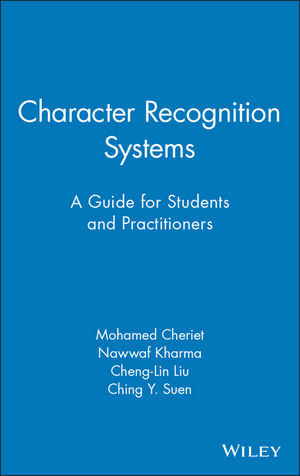Character Recognition Systems: A Guide for Students and PractitionersISBN: 978-0-471-41570-1
Hardcover
360 pages
October 2007
 This is a Print-on-Demand title. It will be printed specifically to fill your order. Please allow an additional 10-15 days delivery time. The book is not returnable.
|
||||||
List of Tables.
Preface.
Acknowledgments.
Acronyms.
1. Introduction: Character Recognition, Evolution and Development.
1.1 Generation and Recognition of Characters.
1.2 History of OCR.
1.3 Development of New Techniques.
1.4 Recent Trends and Movements.
1.5 Organization of the Remaining Chapters.
References.
2. Tools for Image Pre-Processing.
2.1 Generic Form Processing System.
2.2 A Stroke Model for Complex Background Elimination.
2.2.1 Global Gray Level Thresholding.
2.2.2 Local Gray Level Thresholding.
2.2.3 Local Feature Thresholding-Stroke Based Model.
2.2.4 Choosing the Most Efficient Character Extraction Method.
2.2.5 Cleaning up Form Items Using Stroke Based Model.
2.3 A Scale-Space Approach for Visual Data Extraction.
2.3.1 Image Regularization.
2.3.2 Data Extraction.
2.3.3 Concluding Remarks.
2.4 Data Pre-Processing.
2.4.1 Smoothing and Noise Removal.
2.4.2 Skew Detection and Correction.
2.4.3 Slant Correction.
2.4.4 Character Normalization.
2.4.5 Contour Tracing/Analysis.
2.4.6 Thinning.
2.5 Chapter Summary.
References 72.
3. Feature Extraction, Selection and Creation.
3.1 Feature Extraction.
3.1.1 Moments.
3.1.2 Histogram.
3.1.3 Direction Features.
3.1.4 Image Registration.
3.1.5 Hough Transform.
3.1.6 Line-Based Representation.
3.1.7 Fourier Descriptors.
3.1.8 Shape Approximation.
3.1.9 Topological Features.
3.1.10 Linear Transforms.
3.1.11 Kernels.
3.2 Feature Selection for Pattern Classification.
3.2.1 Review of Feature Selection Methods.
3.3 Feature Creation for Pattern Classification.
3.3.1 Categories of Feature Creation.
3.3.2 Review of Feature Creation Methods.
3.3.3 Future Trends.
3.4 Chapter Summary.
References.
4. Pattern Classification Methods.
4.1 Overview of Classification Methods.
4.2 Statistical Methods.
4.2.1 Bayes Decision Theory.
4.2.2 Parametric Methods.
4.2.3 Non-ParametricMethods.
4.3 Artificial Neural Networks.
4.3.1 Single-Layer Neural Network.
4.3.2 Multilayer Perceptron.
4.3.3 Radial Basis Function Network.
4.3.4 Polynomial Network.
4.3.5 Unsupervised Learning.
4.3.6 Learning Vector Quantization.
4.4 Support Vector Machines.
4.4.1 Maximal Margin Classifier.
4.4.2 Soft Margin and Kernels.
4.4.3 Implementation Issues.
4.5 Structural Pattern Recognition.
4.5.1 Attributed String Matching.
4.5.2 Attributed Graph Matching.
4.6 Combining Multiple Classifiers.
4.6.1 Problem Formulation.
4.6.2 Combining Discrete Outputs.
4.6.3 Combining Continuous Outputs.
4.6.4 Dynamic Classifier Selection.
4.6.5 Ensemble Generation.
4.7 A Concrete Example.
4.8 Chapter Summary.
References.
5. Word and String Recognition.
5.1 Introduction.
5.2 Character Segmentation.
5.2.1 Overview of Dissection Techniques.
5.2.2 Segmentation of Handwritten Digits.
5.3 Classification-Based String Recognition.
5.3.1 String Classification Model.
5.3.2 Classifier Design for String Recognition.
5.3.3 Search Strategies.
5.3.4 Strategies for Large Vocabulary.
5.4 HMM-Based Recognition.
5.4.1 Introduction to HMMs.
5.4.2 Theory and Implementation.
5.4.3 Application of HMMs to Text Recognition.
5.4.4 Implementation Issues.
5.4.5 Techniques for Improving HMMs’ Performance.
5.4.6 Summary to HMM-Based Recognition.
5.5 Holistic Methods For Handwritten Word Recognition.
5.5.1 Introduction to Holistic Methods.
5.5.2 Overview of Holistic Methods.
5.5.3 Summary to Holistic Methods.
5.6 Chapter Summary.
References.
6. Case Studies.
6.1 Automatically Generating Pattern Recognizers with Evolutionary Computation.
6.1.1 Motivation.
6.1.2 Introduction.
6.1.3 Hunters and Prey.
6.1.4 Genetic Algorithm.
6.1.5 Experiments.
6.1.6 Analysis.
6.1.7 Future Directions.
6.2 Offline Handwritten Chinese Character Recognition.
6.2.1 Related Works.
6.2.2 System Overview.
6.2.3 Character Normalization.
6.2.4 Direction Feature Extraction.
6.2.5 Classification Methods.
6.2.6 Experiments.
6.2.7 Concluding Remarks.
6.3 Segmentation and Recognition of Handwritten Dates on Canadian Bank Cheques.
6.3.1 Introduction.
6.3.2 System Architecture.
6.3.3 Date Image Segmentation.
6.3.4 Date Image Recognition.
6.3.5 Experimental Results.
6.3.6 Concluding Remarks.
References.



